|
|
|
Sort Order |
|
|
|
Items / Page
|
|
|
|
|
|
|
| Srl | Item |
| 1 |
ID:
173326


|
|
|
|
|
| Summary/Abstract |
Five aspects of the BJP's election campaign contributed to its success in 2019. The first is the personal appeal of the prime minister, which again played a major role, like it did in 2014, as Narendra Modi led a hyper-personalized campaign. Second, this campaign focused on security-related themes which were especially relevant in the context of the India-Pakistan tensions. Third, the BJP campaign strategy was backed by the most formidable election campaign machinery assembled by any party in India since Independence. Fourth, the BJP saturated the public space with the prime minister's image, adroitly using the traditional mainstream media as well as social media. The party used religious appeal to address its core base of supporters while projecting the prime minister's image as a protector and sentinel. Fifth, the latter three aspects of the BJP's campaign were fuelled by unprecedented levels of campaign expenditure and by the opacity of political funding in India, which the BJP had made more impenetrable through the introduction of electoral bonds. The combination of these factors show that the 2019 elections were not business as usual; their singularity largely due to the decline of institutions regulating the electoral process, including the Election Commission of India.
|
|
|
|
|
|
|
|
|
|
|
|
|
|
|
|
| 2 |
ID:
173328
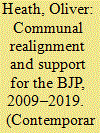

|
|
|
|
|
| Summary/Abstract |
To what extent has the BJP managed to capture the rural vote? And how does the party’s level of support relate to poverty and literacy? Is the Hindu-Muslim divide becoming more pronounced – or has it faded as the party seeks to broaden its appeal? Using constituency level data linked to census data, this article examines support for the BJP and patterns of social realignment at the constituency level from 2009 to 2019. In particular, I examine the impact of social cleavages related to the level of urbanisation, poverty, and literacy within a constituency, as well as its religious and caste profile. Using OLS regression with state-level fixed effects I present a detailed analysis of the social profile of places where the BJP has prospered over the last ten years and the major socio-geographical fault lines that run through the country. The results show that over the last three election cycles support for the BJP has become increasingly polarised along communal lines.
|
|
|
|
|
|
|
|
|
|
|
|
|
|
|
|
| 3 |
ID:
173325
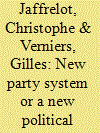

|
|
|
|
|
| Summary/Abstract |
Defying many odds, the BJP has held on to the political space it conquered five years ago and succeeded in expanding its territorial imprint. It did so through a campaign that was substantially different from the 2014 General Election campaign, which was marked by the rejection of the Congress and an enthusiastic embrace of the BJP’s promise of development for all. Five years later, much has changed in India with regard to the political system, which has become more centralized and less liberal. Since the 2019 election, the second Modi-led government has pushed the transition from a de facto Hindu majoritarian state towards a de jure Hindu majoritarian state through the adoption of controversial policies affecting some of the basic normative tenets of India’s old constitutional order, so much so that the BJP’s rise to power has transformed not only the party system, but also the political system itself. This is reflected in India dropping several ranks in most indices of democracy. At the same time, Indian national and state politics have followed divergent paths: the BJP dominates the national stage unchallenged by any rival, but is finding it increasingly difficult to sustain its sway in state elections – leaving the question of the Hindu nationalist hegemony open.
|
|
|
|
|
|
|
|
|
|
|
|
|
|
|
|
| 4 |
ID:
173327


|
|
|
|
|
| Summary/Abstract |
In this article, I develop a model of the politics of vishwas (trust/belief). This is a form of personal politics in which voters prefer to centralize political power in a strong leader, and trust the leader to make good decisions for the polity – in contrast to the standard models of democratic accountability and issue-based politics. I argue that two factors lead to the BJP using the politics of vishwas to dominate Indian politics. First, like much of the world, there is an increasingly strong axis of conflict between those who believe in a unitary (Hindu) national identity for India and those who view India in ‘multicultural’ terms. This obliges supporters of Hindu nationalism to support political centralization to stymie federalism, which would require negotiation across regional, linguistic, caste, and religious identities. Second, the BJP’s control of media and communication with the voter, in tandem with a strong party machinery, give the party structural advantages in mobilizing voters around the messages of Narendra Modi. I find that this change in Indian politics is reflected in voter turnout behavior in India.
|
|
|
|
|
|
|
|
|
|
|
|
|
|
|
|
| 5 |
ID:
173331
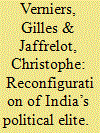

|
|
|
|
|
| Summary/Abstract |
The rise of the BJP in national and state politics is often associated with a representation skewed toward traditional elite groups and the marginalisation of groups associated with other parties, such as minorities and various dominant OBC groups. This article examines the transformation of the sociological composition of the Lok Sabha over time and seeks to assess its elitist character, by providing descriptive statistics on five socio-demographic and economic variables: caste, religion, gender, dynasticism, wealth and occupation. Data suggests that political representation in India has by and large always been skewed toward the elites, but the composition of these elites has changed over time. For instance, the recent surge in the representation of the upper caste in the Lok Sabha pre-dates the rise of the BJP in 2014, and the marginalisation of minorities and women is a long-standing phenomenon. Since 2014 however, the BJP has contributed to enhancing a particular form of elite – those rooted in local and regional business networks.
|
|
|
|
|
|
|
|
|
|
|
|
|
|
|
|
| 6 |
ID:
173329
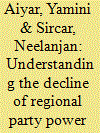

|
|
|
|
|
| Summary/Abstract |
In this piece, we argue that the electoral performance of the BJP, and the popularity of Narendra Modi, has significantly altered the dynamic of regional party politics in India. The BJP’s undiluted power at the Centre has created the political context for greater centralization of power. This in turn has generated greater distinctions between regional and national politics. The popularity of Prime Minister Modi combined with his party’s ideological project generates a deeply centralized national politics that can be easily distinguished from regional politics for the voter. This increasingly distinct form of national politics weakens the role of regional parties in national politics, both in electoral terms and in bargaining power, as regional parties rarely have well-defined, credible national policy platforms in India. However, it does, for the moment, appear to strengthen the electoral position of regional parties at the state level.
|
|
|
|
|
|
|
|
|
|
|
|
|
|
|
|
| 7 |
ID:
173330
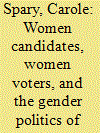

|
|
|
|
|
| Summary/Abstract |
Gender quota campaigns to increase women’s parliamentary presence in India have been ongoing for more than twenty years. Meanwhile, each general election results in the slow growth of women MPs, partly due to political parties nominating few women. The 2019 election was no different in this respect –women still make up fewer than 15% of lower house MPs. Incidents of gendered violence against women candidates also contributed to a characterisation of 2019 as a ‘toxic’ election, and will likely further discourage women’s entry into politics. One positive development, however, was two regional parties’ implementation of voluntary party gender quotas in their parliamentary candidate nominations. This article focuses on women’s political participation as candidates and voters in the 2019 parliamentary election. Parties are scrutinised as key gatekeepers for women’s political recruitment. The article also discusses the new narrative of the growing power of women voters in India, exemplified by closing gender gaps in voter turnout, and representing another aspect of women’s political engagement, potentially influencing parties’ responsiveness to women voters. The article concludes by discussing the broader implications and significance of the 2019 election, areas for further research, and prospects for women’s participation and representation in the new parliament.
|
|
|
|
|
|
|
|
|
|
|
|
|
|
|
|
|
|
|
|
|